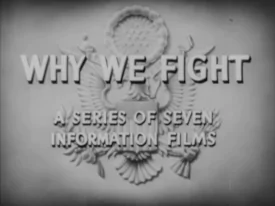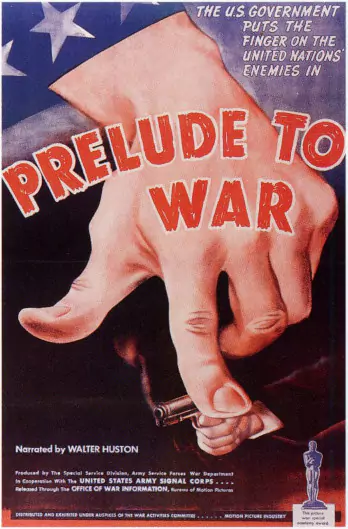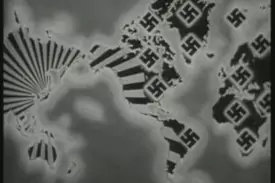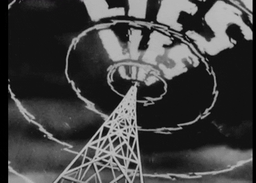More than just a film, “Prelude to War” can be seen as a historical artifact. Representing a time when cinema was used as a means of mass communication to unite a nation’s people and military. Frank Capra, applied his storytelling prowess to craft a compelling narrative that combined factual information with emotional appeal.
Key Takeaways
- Resilience: Building the will to fight enhances personal and collective resilience.
- Leadership: Strong leadership is vital in inspiring and maintaining the will to fight.
- Applicability: The will to fight is essential in both personal and professional spheres for overcoming challenges and achieving success.
Table of Contents
- Frank Capra Why We Fight
- Prelude to War
- What Conclusions Can We Draw From "Prelude to War" and Current U.S. Politics?
- How Can We Compare The Political Environment in the US Today and the Division of the Population?
- The Importance of the Will to Fight in Everyday Life
- Comparing The Axis Powers of WWII and The MAGA movement the Current State of the Republican party?
- Conclusion:
- Crafting The Will To Fight: Why It's Still Important
- Frequently Asked Questions
- What was the purpose of the film "Prelude to War"?
- Who was Frank Capra and what was his role in making "Prelude to War"?
- How did the United States use propaganda during World War II?
- What was the role of propaganda in Nazi Germany during World War II?
- How did Imperial Japan use propaganda during World War II?
Frank Capra Why We Fight
This film is a must-watch
Frank Capra’s “Prelude to War” is the first film of the seven-part “Why We Fight” documentary series, commissioned by the United States government during World War II. The series was intended as a form of propaganda to justify American involvement in the war and to boost the morale of U.S. troops. Here’s an in-depth look at “Prelude to War”:
Background
- Director: Frank Capra, a renowned filmmaker, known for classic films such as “It’s a Wonderful Life” and “Mr. Smith Goes to Washington.”
- Commissioned by: The series was commissioned by the U.S. Army Signal Corps.
- Purpose: “Prelude to War” was designed to explain the reasons for U.S. involvement in WWII to American soldiers and the general public.
Content and Themes
- Contrasting Ideologies: The film contrasts the “American way of life” with the ideologies of the Axis powers (Germany, Italy, and Japan). It depicts the U.S. as a land of freedom and democracy, in stark contrast to the totalitarian regimes of the Axis.
- Propaganda Techniques: The film uses a mix of newsreels, archival footage, speeches, and dramatization to deliver its message. It’s a classic example of wartime propaganda, designed to shape public opinion and morale.
- Music and Narration: The soundtrack and authoritative narration add to the film’s persuasive impact, aiming to stir patriotism and resolve among viewers.
Reception and Impact
- Critical Acclaim: “Prelude to War” won the Academy Award for Best Documentary Feature in 1943.
- Educational Use: Beyond its immediate wartime purpose, the film has been used in educational settings to teach about WWII and the use of propaganda.
- Historical Significance: The film is significant for its historical portrayal of the early years of WWII and for its role in the broader context of propaganda and media during wartime.
Legacy
- Influence on Filmmaking: Capra’s work on the “Why We Fight” series influenced documentary filmmaking, particularly in the realm of persuasive or advocacy-oriented films.
- Historical Document: Today, “Prelude to War” is viewed not only as a piece of propaganda but also as a historical document that reflects the attitudes and governmental strategies of the United States during WWII.
Critique
- Modern Perspective: Modern viewers might critique the film for its simplistic portrayal of complex international dynamics and its overtly propagandistic approach. However, it’s essential to view it within the context of its time.
Prelude to War” and the entire “Why We Fight” series offer a fascinating insight into the use of film as a tool of government policy and propaganda. They also serve as a window into the American perspective and justification for entering World War II, reflecting the societal and political climate of the early 1940s.

Prelude to War

“Prelude to War” is the first film in Frank Capra’s “Why We Fight” series. It was originally released in 1942. The film was commissioned by the U.S. government. Its purpose was to explain the reasons behind America’s involvement in World War II. Although intended for American troops providing context as to why they were entering war. It was also shown to the general public. One of the greatest propaganda films of all time.
Objective and Approach:
The main goal of “Prelude to War” was to contrast the beliefs of the Allies against the totalitarian Axis powers. Namely Nazi Germany, Imperial Japan, and Fascist Italy. Capra aimed to describe the moral difference between the two sides, presenting the war as a necessary battle between good (democracy) and evil (totalitarianism).
Key Themes and Narratives:
The Two Worlds:

The film begins by presenting two contrasting worlds. The first is the democratic world which values freedom, peace, and individual rights. The second is the totalitarian world, characterized by oppression, conquest, and the domination of individual will by the state. Maps are used to visually depict this divide, with free nations illuminated and totalitarian territories shaded dark.
Axis Ambitions:
The film delves into the aggressive ambitions of the Axis powers. Germany, under Adolf Hitler, sought to dominate Europe; Italy, under Benito Mussolini, aimed to resurrect the Roman Empire; and Japan, driven by its imperial desires, looked to control Asia and the Pacific.
Propaganda and Indoctrination:
Capra showcases the propaganda machinery of the Axis powers, emphasizing how they manipulated their citizens and indoctrinated them with extremist ideologies. This is juxtaposed against the ideals of freedom of speech and thought in democratic societies.
The Importance of Preparedness:
“Prelude to War” underscores the dangers of complacency. It highlights how democratic nations, in their desire for peace, initially underestimated the Axis threat, emphasizing the importance of vigilance and preparedness.
Visual and Musical Elements:
Capra masterfully uses a mix of original footage, newsreels, and Axis propaganda films to craft a compelling narrative. Walt Disney Studios aided Carpa’s effort with brilliantly simple animations driving home the intentions of the Axis powers. The film’s score, which uses contrasting menacing tones associated with the Axis powers against uplifting melodies symbolizing democracy, plays a crucial role in setting the mood and reinforcing the film’s themes.
Legacy and Reception:
Upon its release, “Prelude to War” was lauded for its clear and concise presentation of a complex geopolitical landscape. It played a crucial role in galvanizing support for the war effort and providing American soldiers and civilians alike with a clear understanding of the stakes involved.
Today, the film is not just seen as a historical document but also as a masterclass in documentary filmmaking. Its innovative use of visuals, music, and narrative to convey a message is studied in film schools and is considered a testament to Capra’s genius.
What Conclusions Can We Draw From “Prelude to War” and Current U.S. Politics?
When zooming out to view “Prelude to War” a bigger picture we see parallels to the current political climate in the U.S. This involves reflecting on the film’s themes of unity, the dangers of isolationism, and the importance of being informed and engaged in global affairs. Here are several insights:
Unity Against Division:
“Prelude to War” emphasized the strength found in unity—both within a nation and among allied countries—against a common threat. In today’s divided political climate, this underscores the importance of transcending partisan divides to address challenges that affect the nation as a whole, such as public health crises, climate change, and threats to democratic institutions.
Awareness and Engagement:
The film aimed to educate and mobilize a population that was largely isolationist before WWII. Today, it serves as a reminder of the importance of staying informed about global events and understanding the United States’ role in international affairs. In an era of misinformation and disinformation, critical thinking and media literacy are crucial for a healthy democracy.
Lessons in Leadership:
Capra presented a clear narrative of the threats posed by the Axis powers, partly to galvanize support for American leadership in the fight against fascism. Currently, leadership that can articulate the challenges facing the nation and rally collective action is vital. Leaders must navigate complex issues such as international diplomacy, economic inequality, and social justice with clarity and purpose.
The Impact of Propaganda:
Prelude to War” itself was a form of propaganda, designed to shape public opinion. This invites reflection on the power of media and communication in shaping political discourse today. The spread of propaganda and fake news via social media platforms poses a significant challenge to informed public debate and decision-making.
Global Interconnectedness:
The film highlighted the global stakes of WWII and the interconnectedness of nations. Similarly, today’s challenges, from pandemics to climate change, require international cooperation and understanding. The U.S. political climate could benefit from recognizing that isolationism is impractical in an interconnected world and that global challenges necessitate global solutions.
Moral Responsibility:
Finally, “Prelude to War” presented the conflict as a moral battle between the forces of freedom and tyranny. It suggests that nations, including the U.S., have a moral responsibility to defend democratic values, both domestically and abroad. In the current political climate, this resonates with the ongoing debates over human rights, immigration, and America’s role in supporting democracy worldwide.
In sum, “Prelude to War” offers timeless lessons on the importance of unity, informed engagement, leadership, and moral clarity that are relevant to addressing today’s political and social challenges in the U.S. and beyond.
How Can We Compare The Political Environment in the US Today and the Division of the Population?
The lessons from “Prelude to War” regarding unity and the dangers of division can be poignantly applied to today’s political environment in the U.S., where polarization has reached significant levels. Here’s how these themes compare:
Unity vs. Division: “Prelude to War” highlighted the importance of national unity in the face of external threats. Today, internal division is a prominent feature of the American political landscape, with ideological splits often hindering collective action on both domestic and international issues. The film suggests that unity is not just a moral ideal but a practical necessity for overcoming challenges, a lesson that can be applied to addressing today’s divisive politics.
The Dangers of Isolationism: The film also addressed the risks of isolationism in a globalized world. While “Prelude to War” focused on the U.S.’s initial reluctance to enter WWII, today’s form of isolationism can be seen in the reluctance to engage with or understand opposing viewpoints, leading to a fragmented society. This isolation within one’s ideological bubble can be as harmful on a domestic level as geopolitical isolationism is on an international level.
The Importance of the Will to Fight in Everyday Life
Engagement in Global Affairs: Capra’s work underscored the importance of being informed about and engaged in global affairs. In the current U.S. political climate, there’s a parallel need for citizens to be informed about national issues and to engage in the democratic process. Misinformation and disengagement can lead to apathy or misplaced fears, which, in turn, can exacerbate divisions.
Learning from History: “Prelude to War” served as a reminder of the consequences of ignoring rising threats until it’s too late. Today, the U.S. faces various “rising threats,” not all of which are military. Issues such as climate change, social inequality, and misinformation campaigns can also threaten national and global stability. The film suggests the importance of proactive engagement and learning from history to address these challenges effectively.
The Role of Leadership: The film highlighted the role of effective leadership in guiding a nation through perilous times. Today, leadership is equally critical in bridging divides and fostering a sense of common purpose. Leaders who emphasize unity and constructive dialogue over division can play a crucial role in healing polarized societies.
In summary, “Prelude to War” provides timeless lessons on the importance of unity, informed engagement, and proactive leadership. These lessons are particularly relevant in addressing the current political divisions in the U.S., suggesting that overcoming internal divisions is as crucial now as uniting against external threats was during WWII.
Comparing The Axis Powers of WWII and The MAGA movement the Current State of the Republican party?
Comparing historical events to contemporary political movements requires careful consideration of the context, motivations, and outcomes associated with each. The Axis powers in World War II and the MAGA movement within the current state of the Republican Party represent very different phenomena in terms of scale, context, and impact. However, examining the underlying dynamics of political movements and their influence on societal cohesion and democratic institutions can offer insights.
Ideological Polarization:
Both the rise of the Axis powers and the MAGA movement have underscored the potent force of ideological polarization. While the Axis sought to spread totalitarian regimes, the MAGA movement represents a significant ideological shift within the Republican Party, emphasizing nationalism and populism and the spread of hate and distrust. Both cases illustrate how strong ideological currents can lead to deep divisions within and between societies.
Appeal to Nationalism:
The Axis powers and the MAGA movement both leveraged nationalism, although in markedly different contexts and with different objectives. Nationalism, when used to unify a country against perceived external or internal threats, can be a powerful mobilizer. However, it can also exacerbate divisions and undermine pluralistic values if it becomes exclusionary or if it defines the nation in opposition to internal “enemies.”
Impact on Democratic Institutions:
The Axis powers directly sought to dismantle democratic institutions in favor of authoritarian rule. While the MAGA movement operates within the framework of U.S. democracy, its critics argue that some aspects of the movement, such as challenging electoral outcomes or undermining trust in the electoral process, pose challenges to democratic norms and institutions.
Leadership and Personality Cults:
Charismatic leadership played a central role in the Axis powers’ rise, with figures like Hitler, Mussolini, and Tojo embodying the state and the movement. In the MAGA movement, Donald Trump’s leadership style has also fostered a strong personal following, highlighting the role of individual charisma in mobilizing political movements.
Response to Globalization and Change:
The Axis powers capitalized on economic despair, social change, and the perceived failure of existing political systems to protect national interests. Similarly, the MAGA movement has found resonance among those who feel left behind by globalization, economic shifts, and demographic changes, advocating for a return to a prior state of national greatness.
It’s essential to approach such comparisons with nuance, recognizing the unique aspects of each historical and political context. The comparison does not equate the two but rather seeks to understand the dynamics of political movements, their impact on societies, and the challenges they present to democratic practices and institutions.
Conclusion:
“Prelude to War” remains an emblematic piece in the canon of wartime cinema, transcending its era as a profound commentary on democratic principles and the perils of authoritarian rule. Its narrative, which casts the conflict as a moral crusade, still echoes today, reminding contemporary audiences of the stark contrasts between democratic freedoms and totalitarian regimes.
In a modern context, one might draw parallels to documentary films that address the global rise of authoritarian tendencies and the ongoing struggle to uphold democratic ideals. Frank Capra’s work, by aligning the Second World War with a fight for democracy, has continued to influence how filmmakers portray the narrative of liberty versus oppression, ensuring that the spirit of “Why We Fight” endures in educating and mobilizing citizens in defense of democratic values against modern threats. Including within our own Country.
Crafting The Will To Fight: Why It’s Still Important
Frequently Asked Questions
What was the purpose of the film “Prelude to War”?
The film “Prelude to War” was designed to enlighten both U.S. soldiers and the general populace on the rationale behind America’s participation in World War II, while also galvanizing backing for the war endeavor.
Who was Frank Capra and what was his role in making “Prelude to War”?
After the Pearl Harbor attack, Frank Capra, a renowned Hollywood director, shifted his career to serve in the War Department. He contributed to America’s war effort by directing ‘Prelude to War.’’
How did the United States use propaganda during World War II?
During World War II, the United States engaged in propaganda efforts via the Office of War Information by creating movies, posters, and radio programs, and leveraging celebrity support to bolster war endeavors and weaken the adversary spirit.
What was the role of propaganda in Nazi Germany during World War II?
During World War II, Nazi Germany utilized propaganda to prepare its citizens for the war effort, incite anti-Semitic feelings, legitimize territorial conquests, and mask the horrific acts perpetrated upon disenfranchised communities. This was systematically executed by the specialized Ministry of Public Enlightenment and Propaganda.
How did Imperial Japan use propaganda during World War II?
During the mid-to-late 1930s, in preparation for their efforts in World War II, Imperial Japan heavily utilized propaganda films. These films were greatly shaped by the Hokushin-ron doctrine and focused on showcasing Japan’s military prowess as well as its cultural dominance.
Such propagandistic measures were an integral part of Japan’s broader strategy during the global conflict that was World War II.
